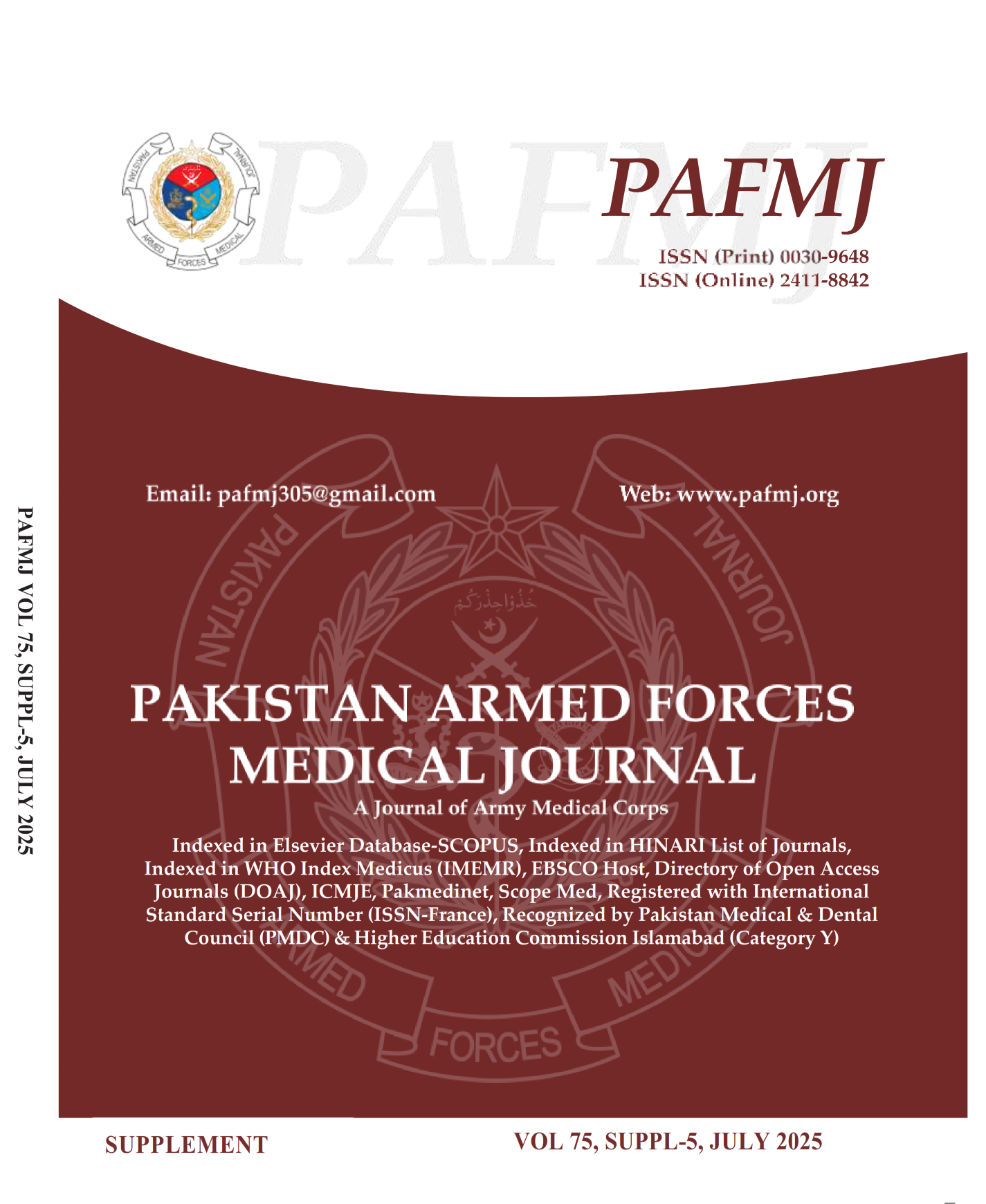Workplace Challenges and their Impact on Quality of Life Among Women in Midlife and Beyond
DOI:
https://doi.org/10.51253/pafmj.v75iSUPPL-5.13273Keywords:
Job Satisfaction, Occupational Stress, Quality of Life, Working Women, Work-Life Balance.Abstract
Objective: To identify workplace challenges experienced by women in midlife and beyond and determine the impact of these challenges on their Quality of Life.
Study Design: Analytical cross-sectional study.
Place and Duration of Study: Islamabad, Pakistan, from March to December 2023.
Methodology: This study included working women between the ages of 45 to 65 years, who were invited to participate in an online survey hosted on Google Forms. The survey was a structed and validated questionnaire, comprising demographic details and questions related to time utilization, job satisfaction and facing workplace challenges.
Results: The researchers enrolled 282 female participants from Islamabad, Pakistan, majority (160, 56.7%) of whom were between the ages of 45-50 years and reported having full-time employment (162, 57.4%). While most participants felt that they did not face organizational discrimination in their workplace (192, 68.1%), a lot of participants also responded that they had faced employment rejection due to being in midlife (176, 62.4%) and had taken extra efforts to maintain their appearance (149, 52.8%). Statistical tests were applied where p-value ≤0.05 was considered significant.
Conclusion: Majority women reported no organizational discrimination at work, experienced no economic challenges and feared no age-related job threats. Participants who reported occasionally taking time off work for themselves and spent time frequently with family and friends felt no need to take early retirement indicating high job satisfaction.
Downloads
References
1. O’Neill MT, Jones V, Reid A. Impact of menopausal symptoms on work and careers: a cross-sectional study. Occup Med 2023; 73(6): 332-8.
https://doi.org/10.1093/occmed/kqad086
2. Adelekan-Kamara Y, Asunramu MH, Bhullar K, Duah-Asante KA, Leedham-Green K, Madaan A, et al. Factors underpinning an improved menopausal experience in the workplace for doctors: a UK-based qualitative study. BMJ Open 2023; 13(3): e060265.
https://doi.org/10.1136/bmjopen-2022-060265
3. Swaminathan A, Lepping P, Kumar G. Menopause, and mental health. Obstet Gynaecol 2023; 25(3): 229-38.
https://doi.org/10.1111/tog.12848
4. Yoeli H, Macnaughton J, McLusky S. Menopausal symptoms and work: a narrative review of women's experiences in casual, informal, or precarious jobs. Maturitas 2021; 150: 14-21.
https://doi.org/10.1016/j.maturitas.2021.05.008
5. Jack G, Riach K, Hickey M, Griffiths A, Hardy C, Hunter M. Menopause in the workplace: Building evidence, changing workplaces, supporting women. Maturitas 2021; 151: 63-4.
https://doi.org/10.1016/j.maturitas.2021.05.002
6. Pitman S. Menopause in the workplace and you. 2022.
7. Hardy C. Menopause and the workplace guidance: What to consider. Post Reprod Health 2020; 26(1): 43-45.
https://doi.org/10.1177/2053369120911063
8. Rees M, Bitzer J, Cano A, Ceausu I, Chedraui P, Durmusoglu F, et al. Global consensus recommendations on menopause in the workplace: a European Menopause and Andropause Society (EMAS) position statement. Maturitas 2021; 151: 55-62.
https://doi.org/10.1016/j.maturitas.2021.05.001
9. Rodrigo CH, Sebire E, Bhattacharya S, Paranjothy S, Black M. Effectiveness of workplace-based interventions to promote wellbeing among menopausal women: a systematic review. Post Reprod Health 2023; 29(2): 99-108.
https://doi.org/10.1177/20533691231161892
10. Unison. The menopause is a workplace issue: guidance and model policy. 2019.
https://www.unison.org.uk/content/uploads/2019/10/25831.pdf
11. Jafari M, Seifi B, Heidari M. Risk assessment: factors contributing to discomfort for menopausal women in the workplace. J Menopausal Med 2017; 23(2): 85-90.
https://doi.org/10.6118/jmm.2017.23.2.85
12. Tonob D, Melby MK. Broadening our perspectives on complementary and alternative medicine for menopause: A narrative review. Maturitas 2017; 99: 79-85.
https://doi.org/10.1016/j.maturitas.2017.01.006
13. Healy G, Bergfeld M. The organising challenges presented by the increased casualisation of ‘women’s work’: a report for the TUC. Centre for Research Equality and Diversity, Queen Mary University of London; 2016.
14. Bariola E, Jack G, Pitts M, Riach K, Sarrel P. Employment conditions and work-related stressors are associated with menopausal symptom reporting among perimenopausal and postmenopausal women. Menopause 2017; 24: 247-51.
https://doi.org/10.1097/GME.0000000000000766
15. Griffiths A, MacLennan SJ, Hassard J. Menopause, and work: an electronic survey of employees’ attitudes in the UK. Maturitas 2013; 76: 155-159.
https://doi.org/10.1016/j.maturitas.2013.06.005
16. Menopause in the workplace and you. 2022.
https://www.researchgate.net/publication/361822667
17. Burn K, Dennerstein L, Browning C, Szoeke C. Patterns of social engagement in the transition to later life. Maturitas 2016; 88: 90-95.
https://doi.org/10.1016/j.maturitas.2016.03.004
18. Shobeiri F, Jenabi E, Poorolajal J, Hazavehei SM. The association between body mass index and hot Flash in midlife women: a meta-analysis. J Menopausal Med 2016; 22: 14-19.
https://doi.org/10.6118/jmm.2016.22.1.14
19. Sarrel PM. Women, work, and menopause. Menopause 2012; 19: 250-252.
https://doi.org/10.1097/gme.0b013e318246dd55
20. Faubion SS, Enders F, Hedges MS, Chaudhry R, Kling JM, Shufelt CL, et al. Impact of menopause symptoms on women in the workplace. Mayo Clin Proc 2023; 98(6): 833-845.
Downloads
Published
License
Copyright (c) 2025 Nabia Tariq, Anum Shahid, Asmara Ahmed Malik, Najm us Saqib Khan

This work is licensed under a Creative Commons Attribution-NonCommercial 4.0 International License.















